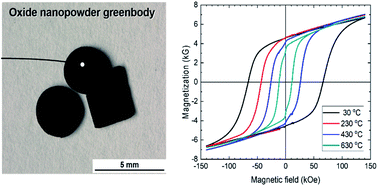Calcium vapor synthesis of extremely coercive SmCo5†
Abstract
Exceptionally coercive SmCo5 particles are produced through calcium vapor reduction of SmCo5O9 powders synthesized by flame spray pyrolysis. The resulting powders are composed of oblate hexagonal particles approximately 2 microns across with smooth surfaces. This microstructure yields record-breaking room temperature coercivity Hc,i >80 kOe, or >60 kOe when combined with advanced manufacturing approaches such as electrophoretic deposition or molding with tetraglyme inks. These techniques enable straightforward low-loss fabrication of bulk parts. The high coercivity is extremely robust at elevated temperatures, exceeding 10 kOe even at 600 °C. The oxide precursor approach removes the need for strict environmental control during synthesis that is common to other nanoparticle-based routes and can readily be scaled to kilogram quantities of feedstock production. Magnet powders produced by calcium vapor reduction can thus function as the building blocks for traditional or advanced manufacturing techniques, while the high coercivity enables consistent performance across a wide range of temperatures.



 Please wait while we load your content...
Please wait while we load your content...